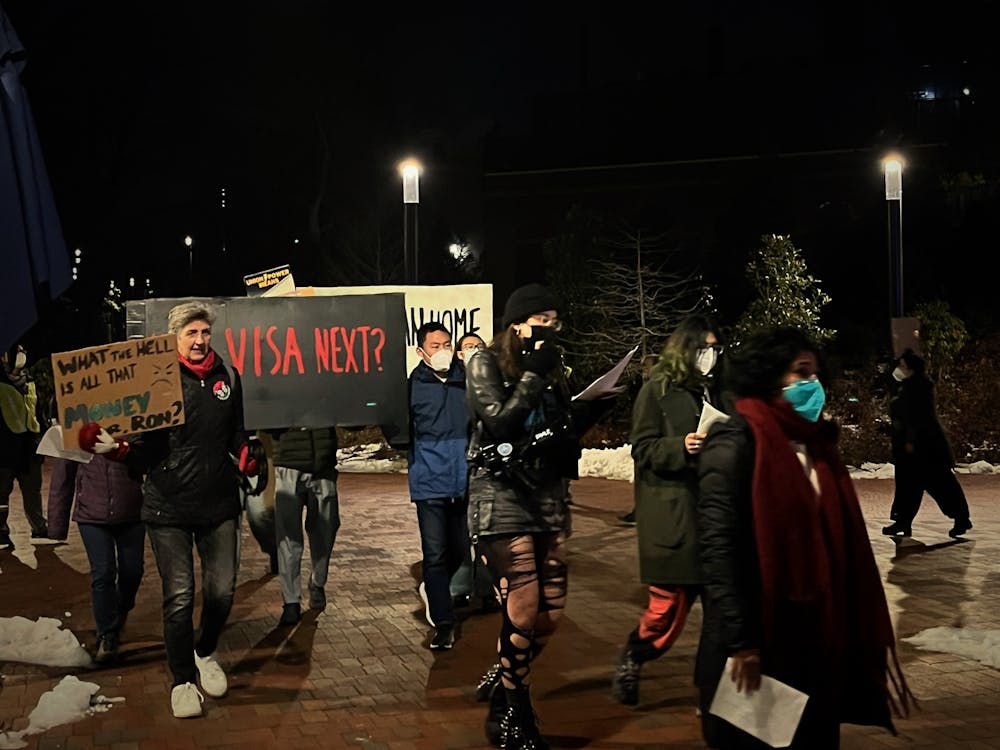The University announced plans to hire 13 new faculty members in three areas of study as part of the Fannie Gaston-Johansson Faculty of Excellence Program (FGJFEP) on Nov. 16.
Named after the University’s first Black woman to become a tenured professor at Hopkins, Fannie Gaston-Johansson, the FGJFEP has resulted in the recruitment of 35 tenure-track professors over a six-year period. The program is part of the Faculty Diversity Initiative (FDI), recently revived under the University’s Second Roadmap on Diversity, Equity and Inclusion.
From nine submitted proposals, the FDJFEP Selection Committee, President Ronald Daniels and Provost Sunil Kumar selected three areas of interdisciplinary study to receive faculty hires: Mathematical Biology, Fluid Mechanics across scales and the Center for Africana Studies. A second call for proposals is planned for later in the academic year, with a March 1 application deadline.
Associate Vice Provost for Faculty Diversity Roland Thorpe explained the selection committee’s process of reviewing proposals in an interview with The News-Letter.
"We had a selection committee who was representative of faculty across the University who have participated in [Diversity, Equity, and Inclusion] efforts either in their research, service, practice or teaching," he said. "It was an NIH style process whereby each application had three reviewers, and we had a rubric, and we had individuals rank each [proposal] on criteria from a scale of 1 to 5."
According to him, the average of the review scores was used as the preliminary score. The committee would then meet to discuss the proposal again and give a final score to decide on their recommendations.
The University established the FDJFEP in 2015, when underrepresented minority representation in faculty was at 8%. This number reached 10% in 2019. According to Thorpe, the statistics for 2022 are not available as a result of differing methodologies.
These faculty diversity demographics lag behind that of the undergraduate student body, which in the fall semester of 2019 was 14.7% Hispanic, 25% Asian and 7.7% Black.
William Egginton, the Decker Professor in the Humanities and Director of the Alexander Grass Humanities Institute, submitted a proposal to increase the representation of Latinx faculty in the Program in Latin American and Latinx Studies, which was not approved. In an email to The News-Letter, Egginton explained the importance of the cluster hire program.
“We have long been aware of the dire underrepresentation at Hopkins of Latinx faculty, and the university’s cluster hire initiative represented and represents a real opportunity for us to help address this important need,” he wrote.
Egginton plans to resubmit the proposal during the second call for submissions and has high hopes that it will be accepted.
Thorpe stressed the importance of the FDJFEP in building community for faculty members from underrepresented minorities in an email to The News-Letter.
“Bringing in individuals and putting them in departments where there’s not much diversity… can create some isolation among the faculty, and we’re trying to prevent that, particularly in the STEM areas,” he wrote.
In an email to The News-Letter, Yolanda Abel, an associate professor at the School of Education, described the importance of diversity, particularly in academic institutions.
“It is important for people to see others who are like them in faculty and/or senior leadership roles,” she wrote. “It is also important as it can help create a diversity of thought that often results in better outcomes to challenges and environments that are more inclusive.”
Junior Kobi Khong also discussed the importance of the University hiring faculty that reflect student diversity in an email to The News-Letter.
“As our student population has grown and benefited from its diversity, the diversity of faculty should keep up so that students can receive a multifaceted education that reflects the diversity and globality of the real world,” he wrote.
Khong is involved with efforts to build a Critical Diaspora Studies (CDS) program at the University. He added that faculty diversity is key for ensuring that courses offer a full and nuanced perspective of the world and that programs like the FDJFEP are a step in the right direction.
Junior Natalie Wang is also a student organizer involved with the CDS program. In an interview with The News-Letter, she detailed issues with faculty diversity at the University.
“The Economics department has never had a Black faculty member… the first Black U.S. historian who was tenured at Hopkins was in 2016, which was not that long ago,” she said. “We also have very little Indigenous representation and representation of people with disabilities.”
Wang stressed that while conversations about faculty diversity often center around race, it is important to recognize the need for diversity across other axes, like disability.
While the FDJFEP focuses primarily on STEM fields, junior DJ Quezada expressed his belief that there needs to be more of an effort in the social sciences to integrate diverse voices.
“I've encountered students who have indicated being taught in an East Asian Studies class by a white Professor doesn't make them feel as comfortable in the classroom experience,” he said.
Quezada added that the University’s position in Baltimore, a city with a population that is 61.6% Black, makes placing emphasis on faculty diversity particularly important.
“It's incumbent on the University, especially with its setting in one of the most diverse cities in the country, to make an affirmative effort to specifically hire people of color into critical faculty roles,” he said.
Wang raised concerns about retaining racially diverse faculty and emphasized that University policies should be equipped to sustain diversity.
“Just because students have faculty that look like them doesn’t necessarily mean that we have an institution or a system that’s just,” she said. “Increasing diversity without changes in institutional policies, for example in areas like safety or policing, we’re just putting more people in danger.”





